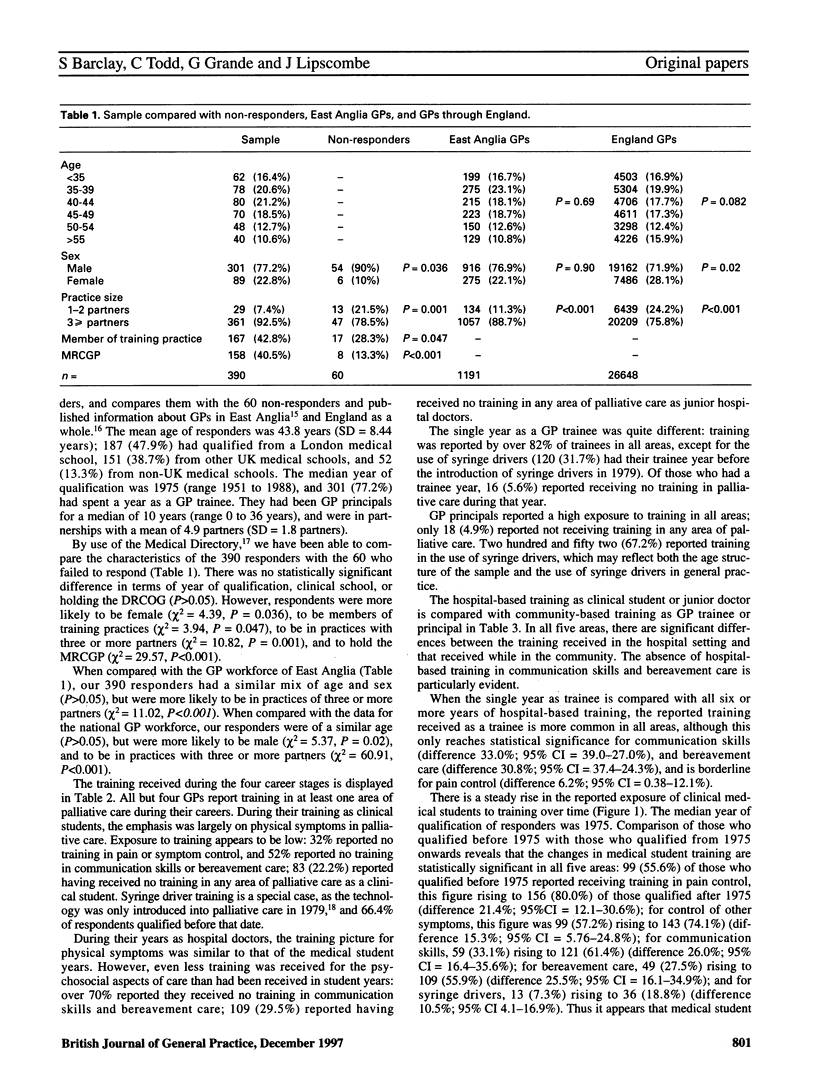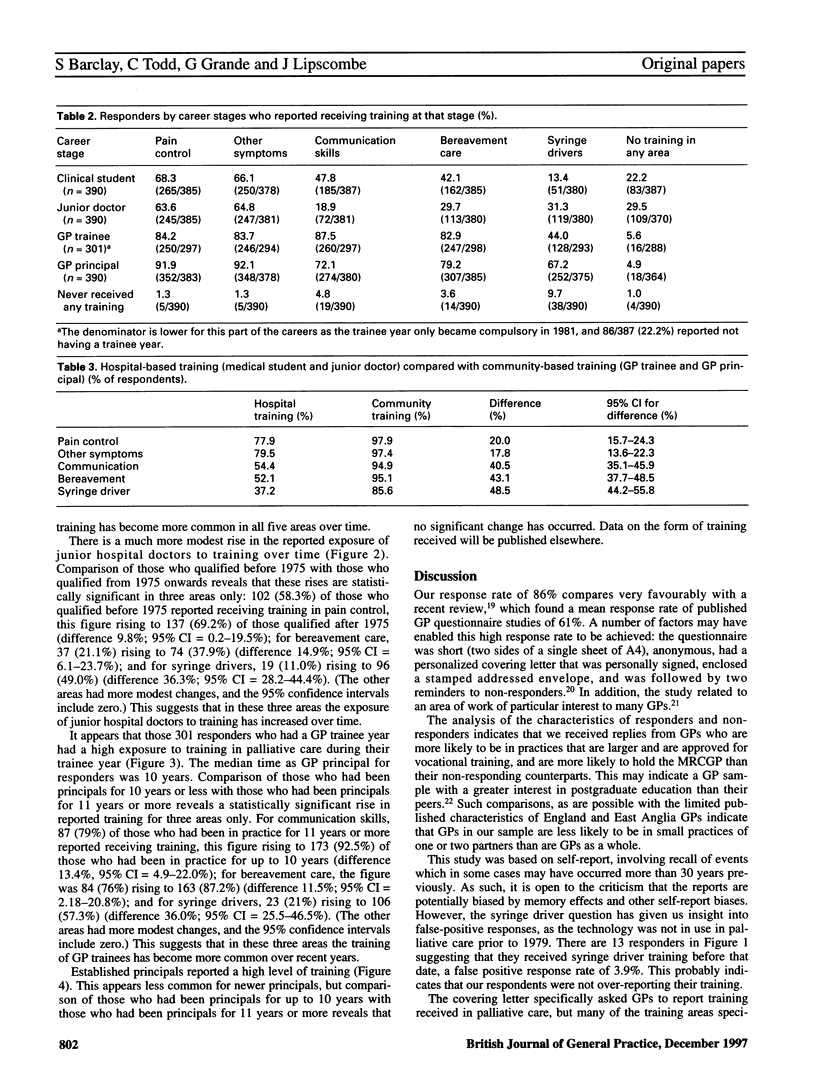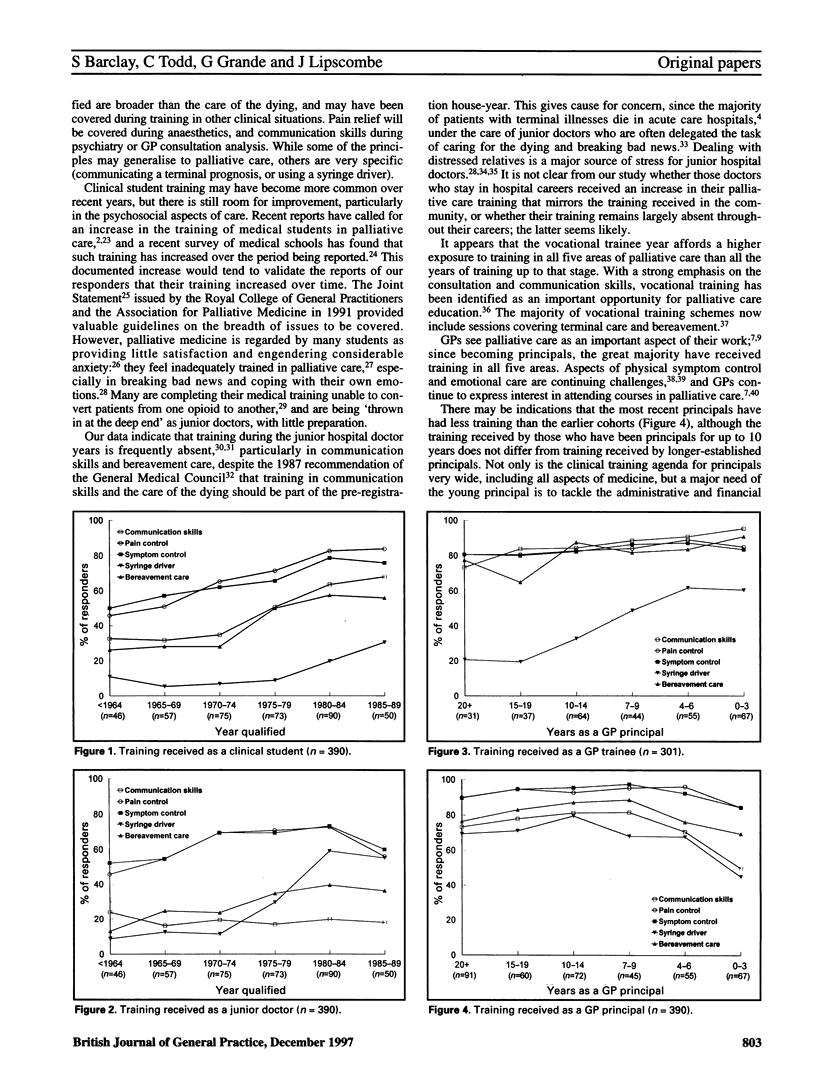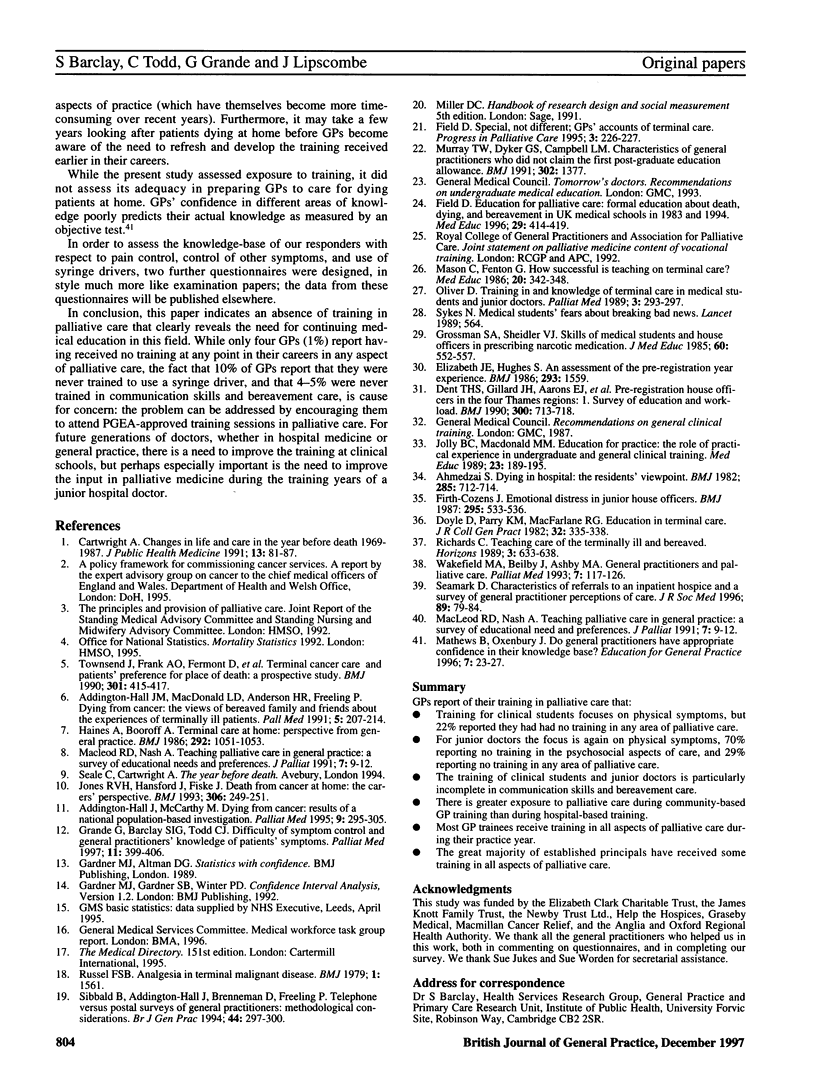Abstract
BACKGROUND: General practitioners (GPs) have a central role in palliative care, yet research continues to reveal room for improvement in symptom control at home. There is a need to evaluate how well-prepared GPs are for this task of caring for the dying at home. AIM: To evaluate the training in palliative care GPs have received throughout their careers. METHOD: Postal survey of 450 randomly selected East Anglian GP principals, investigating training in five areas of palliative care (pain control, control of other symptoms, communication skills, bereavement care, use of syringe driver), as clinical students, junior hospital doctors, GP trainees (registrars), and GP principals. RESULTS: A response rate of 86.7% was obtained. While GPs were clinical students, training was uncommon, (32% reported no training in pain control, and 58% no training in bereavement care), although there has been a significant increase in more recent years. Training as junior doctors was particularly uncommon (over 70% report no training in communication skills or bereavement care); there was some evidence of an increase in more recent years. During the GP trainee year, training was much more common. For GP principals, most areas had been covered, although over 20% reported no training in communication skills and bereavement care. During the community-based years as trainee and principal, training was significantly more common than during the hospital-based years of training as clinical student and junior doctor. CONCLUSIONS: There is a continuing need for medical education in palliative care. Particular attention should be paid to the basic medical education of clinical students and the training of junior doctors, especially regarding communication skills and bereavement care.
Full text
PDF




Selected References
These references are in PubMed. This may not be the complete list of references from this article.
- Addington-Hall J., McCarthy M. Dying from cancer: results of a national population-based investigation. Palliat Med. 1995 Oct;9(4):295–305. doi: 10.1177/026921639500900404. [DOI] [PubMed] [Google Scholar]
- Ahmedzai S. Dying in hospital: the residents' viewpoint. Br Med J (Clin Res Ed) 1982 Sep 11;285(6343):712–714. doi: 10.1136/bmj.285.6343.712. [DOI] [PMC free article] [PubMed] [Google Scholar]
- Cartwright A. Changes in life and care in the year before death 1969-1987. J Public Health Med. 1991 May;13(2):81–87. [PubMed] [Google Scholar]
- Dent T. H., Gillard J. H., Aarons E. J., Crimlisk H. L., Smyth-Pigott P. J. Preregistration house officers in the four Thames regions: I. Survey of education and workload. BMJ. 1990 Mar 17;300(6726):713–716. doi: 10.1136/bmj.300.6726.713. [DOI] [PMC free article] [PubMed] [Google Scholar]
- Doyle D., Parry K. M., MacFarlane R. G. Education in terminal care. J R Coll Gen Pract. 1982 Jun;32(239):335–338. [PMC free article] [PubMed] [Google Scholar]
- Elizabeth J. E., Hughes S. An assessment of the preregistration year experience. Br Med J (Clin Res Ed) 1986 Dec 13;293(6561):1559–1559. doi: 10.1136/bmj.293.6561.1559. [DOI] [PMC free article] [PubMed] [Google Scholar]
- Field D. Education for palliative care: formal education about death, dying and bereavement in UK medical schools in 1983 and 1994. Med Educ. 1995 Nov;29(6):414–419. doi: 10.1111/j.1365-2923.1995.tb02864.x. [DOI] [PubMed] [Google Scholar]
- Firth-Cozens J. Emotional distress in junior house officers. Br Med J (Clin Res Ed) 1987 Aug 29;295(6597):533–536. doi: 10.1136/bmj.295.6597.533. [DOI] [PMC free article] [PubMed] [Google Scholar]
- Grande G. E., Barclay S. I., Todd C. J. Difficulty of symptom control and general practitioners' knowledge of patients' symptoms. Palliat Med. 1997 Sep;11(5):399–406. doi: 10.1177/026921639701100511. [DOI] [PubMed] [Google Scholar]
- Grossman S. A., Sheidler V. R. Skills of medical students and house officers in prescribing narcotic medications. J Med Educ. 1985 Jul;60(7):552–557. doi: 10.1097/00001888-198507000-00007. [DOI] [PubMed] [Google Scholar]
- Haines A., Booroff A. Terminal care at home: perspective from general practice. Br Med J (Clin Res Ed) 1986 Apr 19;292(6527):1051–1053. doi: 10.1136/bmj.292.6527.1051. [DOI] [PMC free article] [PubMed] [Google Scholar]
- Jolly B. C., Macdonald M. M. Education for practice: the role of practical experience in undergraduate and general clinical training. Med Educ. 1989 Mar;23(2):189–195. doi: 10.1111/j.1365-2923.1989.tb00885.x. [DOI] [PubMed] [Google Scholar]
- Jones R. V., Hansford J., Fiske J. Death from cancer at home: the carers' perspective. BMJ. 1993 Jan 23;306(6872):249–251. doi: 10.1136/bmj.306.6872.249. [DOI] [PMC free article] [PubMed] [Google Scholar]
- MacLeod R. D., Nash A. Teaching palliative care in general practice: a survey of educational needs and preferences. J Palliat Care. 1991 Winter;7(4):9–12. [PubMed] [Google Scholar]
- MacLeod R. D., Nash A. Teaching palliative care in general practice: a survey of educational needs and preferences. J Palliat Care. 1991 Winter;7(4):9–12. [PubMed] [Google Scholar]
- Mason C., Fenton G. How successful is teaching on terminal care? Med Educ. 1986 Jul;20(4):342–348. doi: 10.1111/j.1365-2923.1986.tb01377.x. [DOI] [PubMed] [Google Scholar]
- Murray T. S., Dyker G. S., Campbell L. M. Characteristics of general practitioners who did not claim the first postgraduate education allowance. BMJ. 1991 Jun 8;302(6789):1377–1377. doi: 10.1136/bmj.302.6789.1377. [DOI] [PMC free article] [PubMed] [Google Scholar]
- Seamark D. A., Lawrence C., Gilbert J. Characteristics of referrals to an inpatient hospice and a survey of general practitioner perceptions of palliative care. J R Soc Med. 1996 Feb;89(2):79–84. doi: 10.1177/014107689608900206. [DOI] [PMC free article] [PubMed] [Google Scholar]
- Sibbald B., Addington-Hall J., Brenneman D., Freeling P. Telephone versus postal surveys of general practitioners: methodological considerations. Br J Gen Pract. 1994 Jul;44(384):297–300. [PMC free article] [PubMed] [Google Scholar]
- Sykes N. Medical students' fears about breaking bad news. Lancet. 1989 Sep 2;2(8662):564–564. doi: 10.1016/s0140-6736(89)90688-0. [DOI] [PubMed] [Google Scholar]
- Townsend J., Frank A. O., Fermont D., Dyer S., Karran O., Walgrove A., Piper M. Terminal cancer care and patients' preference for place of death: a prospective study. BMJ. 1990 Sep 1;301(6749):415–417. doi: 10.1136/bmj.301.6749.415. [DOI] [PMC free article] [PubMed] [Google Scholar]
- Wakefield M. A., Beilby J., Ashby M. A. General practitioners and palliative care. Palliat Med. 1993;7(2):117–126. doi: 10.1177/026921639300700205. [DOI] [PubMed] [Google Scholar]


